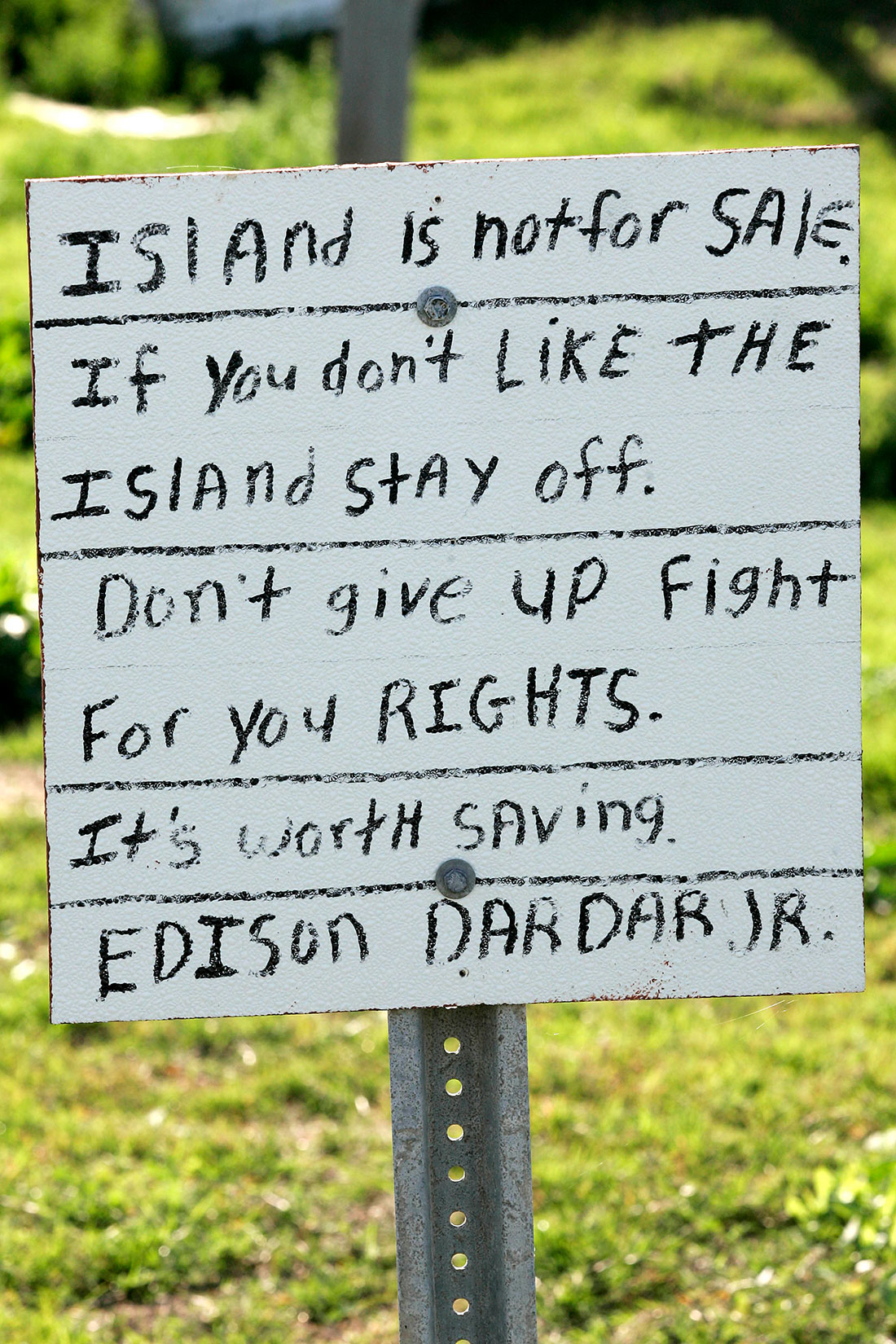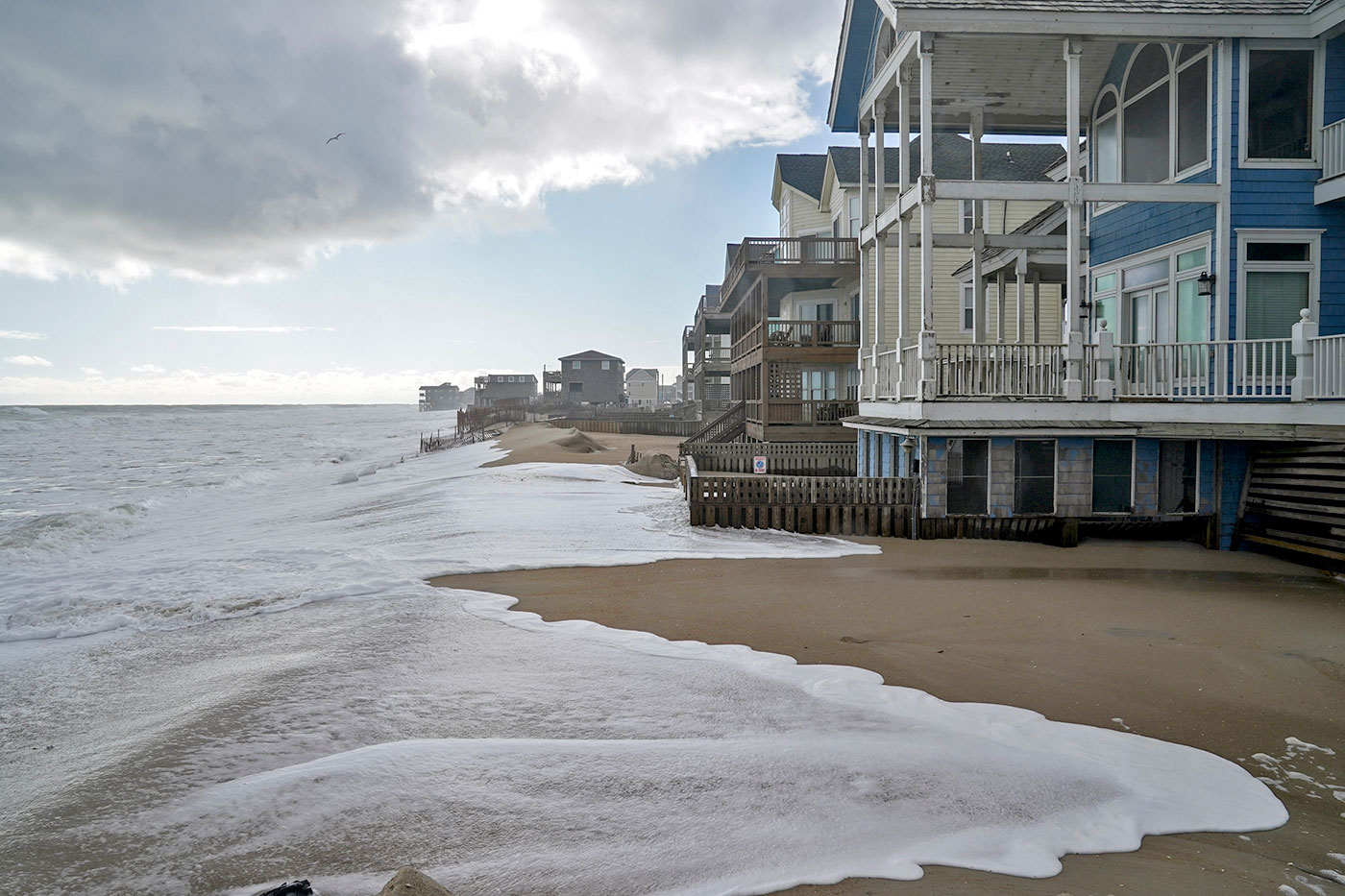This story is part of the Grist arts and culture series Moral Hazards, a weeklong exploration of the complex — sometimes contradictory — factors that drive our ethical decision-making in the age of global warming.
Consider the following scenario: A local government wants to relocate a neighborhood that is vulnerable to climate change. The streets have flooded several times in recent years during major storms, and projections indicate that the flooding will only get worse. This will require the city to send emergency responders into dangerous waters, and then use public money to pay to rebuild the neighborhood’s infrastructure over and over again. If conditions are bad enough, residents could even be killed before first responders can save them from floodwaters.
The city decides to buy out the block, using federal money to purchase residents’ homes and destroy them, leaving behind a vacant stretch of land that can absorb future floods. When officials approach residents and offer them cash payments to vacate the neighborhood, some of them agree to leave. But many others decline the offer and vow to stay put, arguing that they have a deep attachment to the neighborhood — and that the city should build flood walls or retention ponds to protect their neighborhood, rather than moving them out. If even a few homeowners stay, they will ensure that the city remains on the hook for future rescues and repairs. To break the deadlock, the city decides to use its eminent domain power to evict the holdouts from their homes.
Think about it for a minute. Whose side are you on?
After more than five years of reporting on the ways that the U.S. is adapting to climate change, I’ve encountered dozens of instances of this dilemma, where a government’s attempts to implement a “managed retreat” from a vulnerable area collide with the private property rights — as well as the deep, human attachments — of homeowners who don’t want to move. These fights have played out in diverse locales all over the country, from impoverished subdivisions along the bends of the Mississippi River to wealthy cliffside avenues along the California coast, from historically Black neighborhoods to new lily-white suburbs.
When I discuss these stories with readers and friends, I find that people’s reactions depend a lot on who lives in the flood-prone community in question. If it’s a case of a coastal city trying to buy out wealthy beachfront homeowners, readers tend to side with the government trying to force residents to take a payout; if it’s a city trying to buy out a low-income or middle-class neighborhood, readers instead tend to side with the residents. In some cases, in other words, we decide that private property rights trump the public interest, and in other cases we decide the opposite, even when the underlying risk from climate change is the same. Your reaction to the thought experiment above was likely influenced by what kind of community you imagined the hypothetical buyout neighborhood to be.
The U.S. government has funded tens of thousands of home buyouts nationwide, and dozens of local governments across the country have pursued so-called managed retreat efforts with varying degrees of controversy. Even after all these test cases, there exists nothing close to a rubric for deciding when it’s right for a government to force someone to leave their home for the sake of climate adaptation — or when the government has a moral obligation to protect a community that wants to remain in place.
This question involves so much more than managing government budgets and political blowback. The goal of climate adaptation is not only to avert future suffering, but also to build more resilient and better-functioning communities. When residents in vulnerable areas protest against retreat, they’re arguing that relocation would cause them more suffering than staying put in a vulnerable area, and that the only way their community can thrive is if they remain where they are. As the United States and other countries grapple with worsening extreme weather events and the political crises they create, governments need to be sure that their proposed solutions are alleviating the damage of a warming world rather than making it worse.
“You can’t read the fairness of [a retreat] only in the one action,” Linda Shi, a professor of urban planning at Cornell University, told me. “It’s always relative to what is being done in another community.”
Debates over retreat often seem to be clashes between public and private good, where the question is whether the interests of one community are more urgent than the interests of the general public. But retreating from vanishing coasts and other vulnerable areas at the scale that climate change demands will require moving beyond this framework, and instead considering individual relocation as part of a larger adaptation strategy. In order to make moral evaluations of an adaptation effort, we first need to know what that adaptation effort is trying to accomplish — not just for an individual neighborhood or even a city, but more broadly for that community’s state, region, nation, and maybe even the world. In other words, we need to know more about what kind of society we are trying to build once we make it to higher ground.
There is a very simple fact lurking beneath every initiative to adapt to climate change: Even the United States, the richest country in the history of the world, does not have enough money to protect every existing community from climate disasters. The Federal Emergency Management Agency grant programs that currently finance most climate adaptation efforts are funded at just a fraction of demand. Some states and cities fund these projects with local revenue, but most simply don’t have enough cash. Few local governments pay for more than a fraction of the cost of any shoreline defense or buyout initiative. There are finite resources available to build sea walls, firebreaks, and water recycling plants for the vulnerable households that want to stay in harm’s way. In almost every case, buyouts are a more cost-effective solution than capital projects like these.
But the funding available for buyouts is limited, too. Most managed retreat efforts are paid for by competitive federal grant programs, which means that local governments must submit an application and make the case that they should be chosen over other jurisdictions. FEMA and the federal agencies that fund these efforts only care about the individual costs and benefits of each project, not the larger trends that emerge from which projects they choose to support, and where. Buying out one town leaves less money to buy out towns around it with similar risk profiles. When money is finite, in other words, each adaptation project makes every other project more difficult.
The basic fact of this scarcity incentivizes inequality when it comes to adaptation efforts. The U.S. and its local governments have been moving people away from climate harms for decades now, and the vast majority of those relocations have been voluntary buyout agreements between willing homeowners and public agencies. The government enjoys broad legal authority to move people out of their homes to promote the public interest, so long as it provides property owners with what the U.S. Constitution calls “just compensation.”
This seemingly universal doctrine is unfair in a fundamental sense, however, since it makes it far easier for a government to buy out and relocate a poor neighborhood than a wealthy one. The cost of relocating an area like Houston’s Allen Field, a majority-Latino neighborhood where many homes cost less than $100,000, is a fraction of what it would cost to relocate a wealthy community like those in North Carolina’s Outer Banks, where the kind of beachfront vacation home at risk of simply collapsing into the sea can cost a million dollars or more. Even if the latter community is at greater risk, cost considerations alone disincentivize bureaucrats from trying to strong-arm wealthy homeowners out of their property.

Jahi Chikwendiu / The Washington Post via Getty Images
Wealthy residents are also more likely to have not just the money but also the time and connections that it takes to fight the government. Indeed, some wealthy Outer Banks homeowners have spent years waging legal battles against government efforts to limit coastal construction and remove precarious homes, often with assistance from conservative law groups like the Pacific Legal Foundation. Even the threat of these lawsuits can scare off governments attempting to pursue managed retreat: When I wrote about California’s attempts to limit coastal development, a Malibu city council member told me he was terrified that residents would sue if the city imposed construction limits on coastal areas.
The uneven legal landscape around eminent domain is one reason why past managed retreat patterns have been so unequal in the United States. One study of adaptation actions in North Carolina, for instance, found that “[property acquisitions] are found to correlate with low home values, household incomes, and population density and high racial diversity.”
An even more vexed issue is what counts as “just compensation.” If the government gives a homeowner the pre-flood market value of her home, is that enough? That’s the way most courts have ruled, but it’s easy to argue otherwise. If the government is razing a low-income neighborhood, residents may well not have enough money to afford homes in nearby areas. This happened in Kinston, North Carolina, one of the first places where FEMA attempted a major buyout around the turn of this century. Residents of a historic Black neighborhood relocated to wealthier white areas only to enter foreclosure when they fell behind on mortgage payments down the road.
There are emotional and spiritual considerations, too. After all, a community is not just a collection of houses but a tangle of social relations and cultural practices. In uprooting the residents of a fishing village from their homes and scattering them around a city, the government destroys those relationships and traditions. Relocated residents can lose their friends, their social support systems, their favorite spaces to play, their proximity to their jobs and sources of income, and even their connection to land and nature. These are huge losses, and they often can’t be captured in a dollar amount.
“It’s very limiting to conceptualize retreat in terms of property and possessions, rather than asking, ‘What kinds of relationships with my community I am able to maintain?’” said Simona Capisani, a political philosopher at Durham University in the United Kingdom who has studied the ethics of climate migration.
Many governments have recognized that Indigenous communities have an inviolate right to maintain communal bonds and cultural forms, though they have seldom made good on that recognition. When the state of Louisiana used federal money to relocate the eroding Indigenous community of Isle de Jean Charles starting in 2016, officials promised to build a new community with a fishing bayou and homes built in the island’s architectural vernacular. Instead, they ended up building an ordinary-looking subdivision that tribespeople from the island decried as shoddy and foreign. Some residents pulled out of the relocation effort altogether, opting to move elsewhere or in some cases to stay put on the eroding island.


It seems inarguable that Indigenous nations who have been dispossessed of their land in the past should enjoy ample support to stay or move from at-risk areas as they choose. Beyond that, however, it’s hard to figure out where to draw the line between communities that merit similar consideration and those that don’t. The residents of Malibu and the Outer Banks could argue that their ways of life carry intangible value for them, too, but it would be absurd to claim that the government should have to provide residents of those areas with compensation for the culture they would lose by relocating (in addition to the compensation already forthcoming for their million-dollar homes).
A strategy that designed adaptation efforts around local consensus would work in some communities, especially those like the neighborhoods on New York’s Staten Island where residents rallied around buyouts after 2012’s Superstorm Sandy, but it would quickly run up against questions about how to define community consensus, not to mention massive funding constraints. Residents of rural villages will want flood-proofing infrastructure just as much as city dwellers, but building rural infrastructure provides far fewer benefits per dollar spent. If you take an approach designed to optimize bang-for-buck, you’ll end up building sea walls to protect wealthy cities and buying out poor towns, or maybe even leaving rural areas with no protection whatsoever.
Underlying all these considerations are further questions with no easy answers: What values or criteria could we use to decide whether a community should have to relocate, even if its residents don’t want to leave? Is it about a certain length of land tenure in a given place, or a place’s aesthetic or cultural uniqueness compared to the areas that surround it? And if marginalized communities have a claim on this kind of compensation, then how do we decide what forms of marginalization merit compensation? There has to be another calculus beyond the dollar. But what?
The stakes of coming up with good answers to these questions are high. If we admit that managed retreat has a moral dimension — that it isn’t just a logistical question of relocating people from unsafe areas to safe ones — then we should have a clear sense of which acts are justified and which ones aren’t, beyond a feeling in our collective gut. The moral quandary of managed retreat is not only that public and private interests conflict, but also that every adaptation effort in a vulnerable area implies a hierarchy of value and need.
The way out of this conundrum may be counterintuitive. Instead of avoiding the idea of a hierarchy, what if we embraced it? It’s tempting to think about each retreat effort as a separate moral question, one that involves weighing the interests of individual homeowners or communities against a collective “public” represented by the government and its taxpayers. Instead, we could think about each individual relocation as part of a broader nationwide effort to reduce vulnerability to climate change, and evaluate the justice of that effort as a whole, rather than trying to decide between competing interests in any one community.
There is some precedent for such an approach. During the Obama administration, the National Park Service started to outline a policy for how to respond to climate disasters, acknowledging that global warming would make it impossible to protect every sliver of the nation’s immense natural, historical, and architectural heritage. Marcy Rockman, the archaeologist who led the effort, imagined that rather than creating a hierarchy of heritage sites based on some criteria of worth, the government could prioritize diversity. The success of this climate program would not rest on identifying the “worthiest” or “most at risk” places, but instead on finding a way to consider and address the needs of as many types of heritage in as many different environments and communities as it could.
“[We need] that ability to sit down with a community … one that is facing some sort of relocation, and say, ‘You know, we can’t hold back the sea. We cannot keep things as they are,” said Rockman. But after acknowledging this threat, she added, residents could be asked exactly what it is that they want to save from their longtime communities, and public policy can follow that lead.
The National Park Service halted Rockman’s effort during the Trump administration, and the Biden administration has not resumed it. When it comes to adapting to climate change, U.S. policy involves nothing like Rockman’s vision of a comprehensive evaluation. Even though the government has been funding climate adaptation in one form or another for decades now, we have no nationwide or even regional strategy that guides our efforts.
As a result, there’s no intention behind the distribution of managed retreat efforts. Instead, relocations happen because disasters strike and local officials secure grant money, or because coastal homes suddenly start falling into the sea — not because any larger entity has decided that relocations should happen in those places as opposed to others. The government is required to conduct cost-benefit analyses for every adaptation project, but these analyses only consider the costs to the government for funding the project and the benefits to the community where the project takes place — not any larger questions about how a relocation or a sea wall might fit within the broader dynamics of a shoreline, a regional economy, or a national culture.
One can imagine bringing a holistic approach like Rockman’s to a nationwide adaptation strategy that is centered on the needs of people, rather than the cultural artifacts that are the purview of the National Park Service. This would shift policy away from the current focus on localized costs and toward the broad characteristics of a relocation program across a region or even the entire country. If the government articulated a clear unifying purpose for its managed retreat efforts, it would be easier to evaluate the justice of any specific buyout or land seizure, and easier to debate those acts in the political sphere.
To create such an adaptation plan would be the work of generations, but it’s possible to imagine agreement on a few basic principles for how it might work. Because the federal government will remain by far the largest funder of adaptation efforts, a national climate adaptation initiative would need permanent financing from Congress. The initiative could be housed under the Department of the Interior, or the Department of Housing and Urban Development, or perhaps even an independent commission that would be better shielded from partisan interference.
Though federal funding and coordination would be essential, a national adaptation plan might work best if divided into discrete regional efforts, treating broad areas like the Gulf Coast and the sinking shoreline of the Chesapeake Bay as the units of focus. Rather than parceling out money to a plethora of states, counties, and towns, a single council or commission could be formed for each region. These deliberative bodies would map vulnerable areas, conduct hearings and listening sessions with residents, compile catalogs of cultural and historical treasures, and estimate the cost of providing each community with the adaptation projects it needs — and the projects its residents desire.
In all likelihood, the cost of the resulting wish lists would exceed the available funding, so each commission would need to create a hierarchy of priority for where to build sea walls and shoreline protections, where to acquire and destroy homes, and where to do nothing.
To be sure, any such hierarchy would have its critics, and even a conscientious and consensus-driven adaptation effort would fail to persuade some holdouts, which would entail litigation and the continued backstop of eminent domain. Even so, the deliberate articulation of such a hierarchy would enable the pursuit of a coherent social goal — one that could combine Rockman’s efforts to preserve cultural heritage with a reparative attempt to foster economic and racial equity.
Rather than allocate funding based on a localized cost-benefit analysis — and in effect only protecting the densest areas with the highest property values — a regional commission could allocate its limited budget for levees and sea walls dedicated to marginalized communities, ensuring that they retain the social cohesion and property tenure that were denied to them under more prejudiced governments in the past. And in cases where middle-class homeowners are bought out and relocated, the government could still build new housing on higher ground to make up for the lost supply, or give residents moving stipends that are indexed to household income and the local property market, rather than the value of their lost property. The wealthiest coastal enclaves might receive little or no infrastructure aid in recognition of their existing advantages, and those who take buyouts on expensive second homes could make do with their market-value compensation, as they do today.

Jahi Chikwendiu / The Washington Post via Getty Images
With a comprehensive strategy that would roll out over multiple decades, rather than a series of ad hoc land use decisions made to triage life-threatening risk, public officials could avoid many of the most difficult legal and political controversies that attend managed retreat today. Rather than try to relocate every holdout within a matter of a few years, a government could send clear advance signals to residents that their communities can’t stay as they are forever. It could buy a home from an elderly homeowner and rent it back to them until they pass away, for instance, or slowly reduce utility and road service to a neighborhood as its population declines. While even long-term consensus-building efforts would likely still face legal challenges, they would be easier and cheaper than fighting thousands of one-off fights over individual uses of eminent domain.
“What if we didn’t think about relocation as, ‘We’re going to move people out today’?” said A.R. Siders, a professor at the University of Delaware and one of the nation’s foremost experts on managed retreat. “What if we thought about it as, ‘Where are the places where the people who are in their homes right now are the last people to own those homes?’ That’s still going to be emotionally difficult and challenging, but you have years to prepare.”
On the preservation side, a regional commission could dedicate money to safeguarding representative samples of a region’s culture. On the Gulf Coast, for instance, funds could be directed toward protecting at least one shrimping village, one community of fishing camps, and one subdivision of bayou homes. In the fire-prone mountains of California, money might go toward preserving at least one historic mining town, one trailer park, and one ritzy cul-de-sac. In places where climate change and extreme weather have accelerated such that communities simply cannot be saved, the government could poll residents on what artifacts most represent their community, then preserve them in a museum, much as the relics of Pompeii have long been housed in a museum in Naples, Italy.
Such an effort would take an enormous amount of forethought and transparency to be successful, and a just outcome is far from guaranteed. But even if this sort of comprehensive plan fails, at least its coherence allows people to agree or disagree with the overall way that their representatives decide to handle the task of adapting to climate change.
As Siders puts it, the process of adaptation in this case would look less like a series of confrontations between the state and private citizens, and more like a collective attempt — however imperfect and rickety — to sketch the contours of a new nation: “What if we flip it and we say not just, ‘Who are we going to make move?’ but, ‘What is the future we’re trying to build?’”






